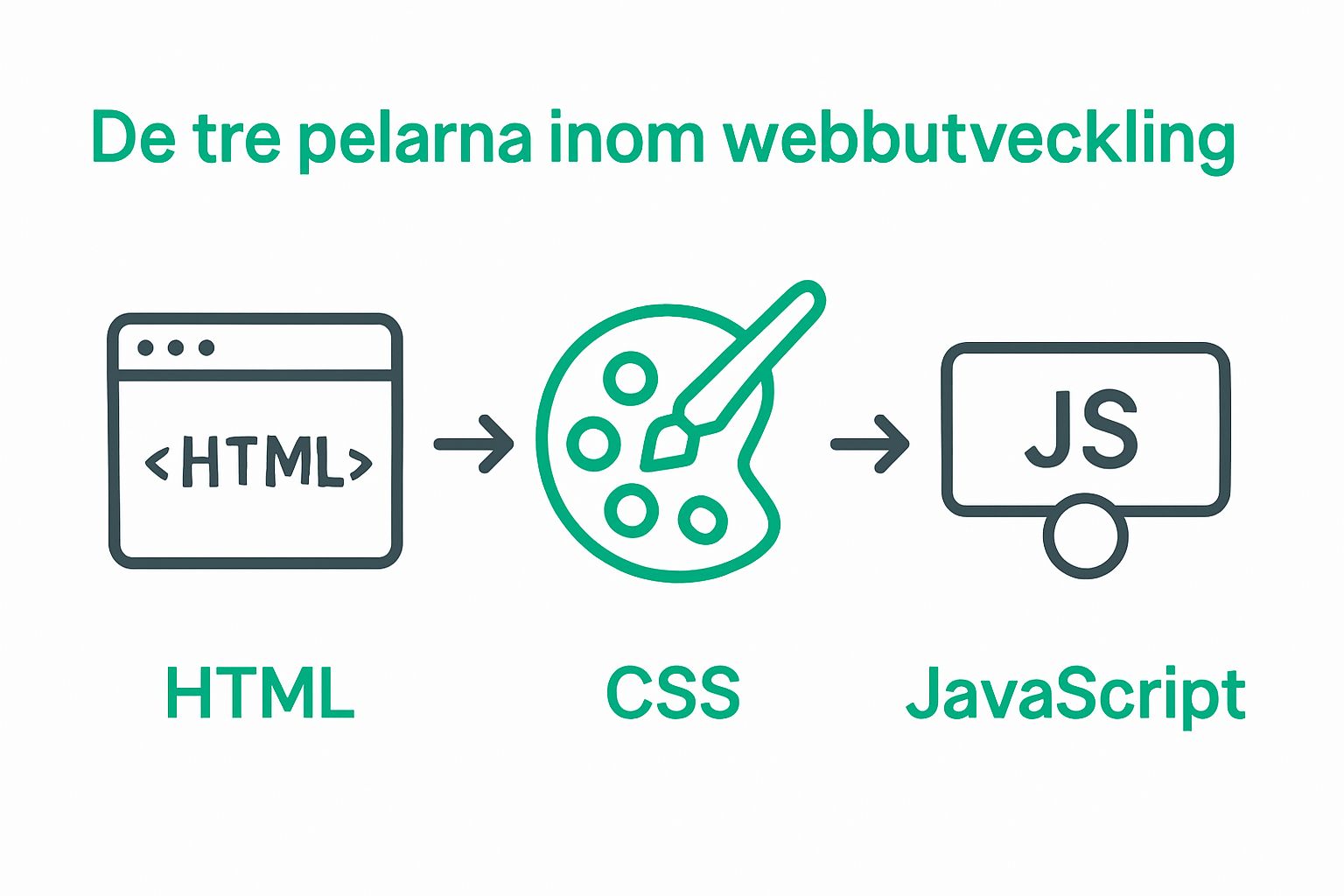Web development affects everything from the visibility of small businesses to how we experience the internet every day. Statistics show that over 80 percent of consumers search for information about companies online before purchasingMany people think that the hardest part of web development is the coding itself. But the biggest boost comes from how technology creates fast, intuitive experiences for the user – and that changes the playing field completely.
Table of contents
- What does web development mean and its concepts?
- Why is web development important for businesses?
- How does web development work in practice?
- Key components in web development
- The future of web development and its impact
Summary
| Takeaway | Explanation |
|---|---|
| Web development is necessary for businesses | Creating a professional website is crucial for reaching customers and increasing credibility. |
| Frontend and backend are central areas | Understanding both visual interfaces and server-side logic is important for modern web development. |
| Customer experience affects business results | A well-optimized website improves the user experience and can increase conversion rates. |
| Web development requires different skills | Development includes planning, design, coding and testing to ensure quality. |
| The future holds more technological innovations | Adaptive technologies and AI will shape how websites interact with users. |
What does web development mean and its concepts?
Web development is a dynamic and complex process that involves creating, designing, and maintaining websites and web applications. According to IBM This work includes everything from the visual design to the technical infrastructure that makes a website function smoothly and efficiently.
Technical basics of web development
Web development is built on several fundamental programming languages and technologies that work together to create interactive and responsive digital experiences. The key components include:
- HTML (Hypertext Markup Language): Structures web content and defines different elements on a page
- CSS (Cascading Style Sheets): Handles the visual presentation and design
- JavaScript: Creates interactive and dynamic features that make websites more engaging
Different forms of web development
Web development can be divided into two primary categories: frontend and backend.
Frontend is about the visual interface that users directly interact with, while backend focuses on server logic, databases, and the technical processes that power the website. According to Mozilla Developer Network Modern web development requires a deep understanding of both of these aspects.
For small and medium-sized businesses looking to expand online, web development is no longer a choice but a necessity. By create a professional website companies can build credibility, reach wider audiences and create new business opportunities in the digital world.
Modern web development is not just about coding, but also about creating user experiences that are intuitive, fast, and responsive across devices and screen sizes. It is a continuous process of design, implementation, testing, and optimization that requires creativity, technical skill, and strategic thinking.
Why is web development important for businesses?
Web development has become crucial to the success and digital competitiveness of modern businesses. According to Forbes, a well-designed website represents more than just a digital presence – it is a powerful tool for marketing, communication, and sales.
Digital marketing and visibility
For small and medium-sized businesses, a professional website is the key to visibility and reaching potential customers. A well-thought-out website serves as a digital storefront that presents the company's brand, services and values. Through strategic web development, companies can:
- Increase your digital visibility and credibility
- Reach a wider geographic market
- Create effective communication channels with customers
Customer experience and conversion
Modern web development is about creating user experiences that are intuitive, responsive, and engaging. According to Google The design and functionality of the website determines direct business results. A well-optimized website can:
Here is a table that compares frontend and backend in web development and clarifies their different roles and areas of expertise.
| Area | Frontend | Backend |
|---|---|---|
| Purpose | Designing the user interface | Manages server logic and database |
| Use | Direct interaction with the user | Runs on the server, invisible to the user |
| Main language | HTML, CSS, JavaScript | PHP, Python, Ruby, Node.js |
| Focus | Design, layout, user experience | Functionality, data security, logic |
| Example tools | React, Angular, Vue.js | MySQL, MongoDB, Express.js |
- Improve customer navigation capabilities
- Increase conversion rate
- Reduce bounce rate and improve user experience
Web development is no longer a luxury choice but a fundamental business strategy. By investing in professional web development, companies can build stronger digital platforms that generate leads, increase sales, and strengthen the brand's digital presence.

How does web development work in practice?
Web development is a complex process that requires coordinated efforts from various experts and technologies. According to GeekforGeeks Practical web development is about systematically creating and maintaining digital platforms that meet specific business needs and user expectations.
The different phases of the development process
The practical web development process consists of several critical steps that ensure a successful website. A full stack developer usually works with all phases:
- Planning: Define project goals, target audience and technical requirements
- Design: Create visual layout and user interface
- Development: Implement functionality through coding
- Testing: Check performance and user experience
- Launch and maintenance: Publish the website and continuously update it
Technical tools and methods
According to Mozilla Developer Network Modern web developers use advanced tools and frameworks to streamline the development process. Some key technologies include:
- Version control systems like Git
- Frameworks like React, Angular, and Vue.js
- Development environments like Visual Studio Code
- Cloud platforms for hosting and distribution
Successful web development requires more than technical skill – it's about creating digital experiences that are intuitive, fast, and tailored to users' needs.
Below, the different phases of the web development process are organized and explain the main focus of each step.
| Phase | Main task |
|---|---|
| Planning | Define project goals and technical requirements |
| Design | Create layout and plan user interfaces |
| Development | Program and implement functionality |
| Testing | Ensuring performance and ease of use |
| Launch/Maintenance | Publish and continuously update the website |
| Through continuous learning and adaptation, developers can create websites that not only look great, but also deliver real business value. |
Key components in web development
Web development is a complex field that requires interaction between different technologies and components. According to W3Schools Programming languages and technical frameworks form the foundation of all modern web development.
Basic programming languages
Creating functional and responsive websites requires mastery of several core programming languages.
 How to make your website responsive depends largely on knowledge in:
How to make your website responsive depends largely on knowledge in:
- HTML: Creates the basic structure and content of the website
- CSS: Handles design, layout and visual presentation
- JavaScript: Enables interactive elements and dynamic features
Advanced development tools
According to IBM, modern web development processes involve much more than just basic coding. Key components include:
- Frameworks like React, Angular, and Vue.js
- Version control systems like Git
- Cloud platforms for hosting and distribution
- Testing tools and debugging environments
Successful web development is about more than technical expertise. It requires creativity, problem-solving skills, and the ability to understand both technical details and the overall user experience. Through continuous learning and adaptation, developers can create websites that are not only functional, but also intuitive and engaging.
The future of web development and its impact
Web development is undergoing a rapid and dynamic transformation that will impact how businesses and organizations communicate digitally. According to Gartner, technological innovations are expected to radically change digital experiences in the coming years.
Technology developments and trends
The future of web development will be characterized by intelligent and adaptive technologies. New digital trends points to the following crucial changes:
- Artificial intelligence that creates personalized user experiences
- Increased integration of machine learning into web applications
- Improved cybersecurity through advanced authentication methods
User experience and accessibility
According to the World Wide Web Consortium, future web development will focus on:
- Responsive design that works seamlessly on all devices
- Improved accessibility for users with disabilities
- Faster loading times through optimized coding
- More intuitive and intelligent interfaces
The future of web development is not just about technological advancements, but about creating meaningful digital experiences that are inclusive, efficient, and tailored to individual user needs. Through continuous innovation and user focus, web developers can shape digital environments that are more cohesive, intelligent, and engaging than ever before.
Take the step from knowledge to real digital success
Do you understand the value of web development but feel unsure about the next step towards a professional website that really delivers? This article discusses how important a responsive and user-friendly website is to increase visibility and build trust. Many companies get stuck in the planning phase and lack the technical skills or resources to turn their vision into reality. You may have already identified the need to improve your customer experience or create a platform that works seamlessly across devices. Our web development experts know how to turn technology and design into measurable business value and help you avoid common mistakes that can cost you time and customers.

Boost your digital presence today. Visit iMarketing.se and get a customized quote based on your unique needs and goals. Contact us directly for personal advice and discover how we can develop and optimize your website for growth. Don’t let technical obstacles stand in the way of your next step – book a meeting with us via the web development page and let us show you how the right strategy leads to real digital expansion.
Frequently asked questions
What is web development?
Web development is the process of creating, designing, and maintaining websites and web applications. It includes both the frontend (the user interface) and the backend (server logic and databases).
What programming languages are used in web development?
The primary programming languages in web development include HTML for structure, CSS for design, and JavaScript for interactivity.
Why is web development important for businesses?
Web development contributes to the company's digital presence, increases visibility and credibility, and creates effective communication channels with customers.
What does a responsive website mean?
A responsive website is designed to function optimally on different devices and screen sizes, improving user experience and accessibility.


